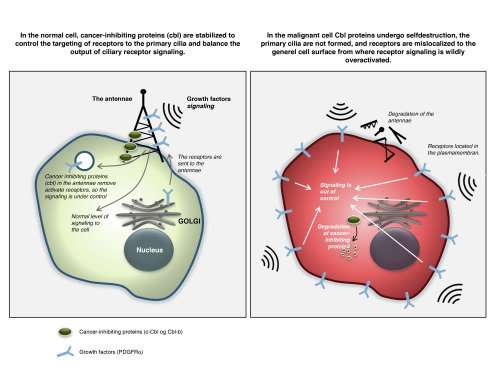New research linking cancer-inhibiting proteins to cell antennae

Danish researchers have just presented a previously unknown mechanism that inhibits the ability of cells to develop into cancer cells. Their findings have important implications for the understanding of how cancer starts, and how to improve the treatment of illness in the future. The discovery is published today in the internationally recognized Journal of Cell Biology.
Under the leadership of Professor Søren Tvorup Christensen and Associate Professor Lotte Bang Pedersen, researchers at the University of Copenhagen's Department of Biology have taken an important step forward in understanding the very complex mechanisms by which the cells in our body are able to maintain their normal function, and how defects in these mechanisms could trigger cancer cell formation.
The researchers began by referencing a previous discovery of their own: Certain types of signaling molecules are detected by specific receptors (PDGFRα) in what are known as primary cilia. These cilia are present as single units on nearly all cell types in the human body and they function as cellular antennae that detect and transmit extracellular cues to control embryonic development and maintain tissue and organ function in adults. The research group has now demonstrated that the very same antennae also play a crucial role in the balancing of the output of PDGFRα signaling so that the signaling doesn't get out of control. Unconstrained, excessive signaling from these receptors increases the risk—of brain tumor and gastrointestinal cancer development.
"Our results demonstrate that, under normal conditions, primary cilia serve to inhibit processes that can lead to cancer. We have shown that specific cancer-inhibiting proteins of the Cbl-family mediate the targeting of PDGFRα to the cilia, and once located in these antennae, the Cbl proteins prevent excessive receptor activation. Further, we have demonstrated that stabilization and functionality of the Cbl proteins are regulated by an entirely new mechanism, which also is associated with the cilia. Should this mechanism be disturbed, the Cbl proteins will undergo self-destruction, which in turn will lead to mislocalization of the receptors to the general cell surface from where the receptors are wildly over-activated," according to Professor Christensen.
The result is dramatic because cell antennae will now play an entirely new role in both our understanding of tumor progression and in the development of improved diagnostic and treatment methods for patients affected by certain types of cancer. According to the research group, it is likely that other illnesses are also linked to Cbl-protein protection errors.
"Defects in Cbl proteins are also associated with leukemia and autoimmune diseases. Therefore, our hope is that this discovery will contribute to a better understanding of the mechanisms that lead to these other very complicated illnesses," concludes Søren Tvorup Christensen.
More information: Fabian Marc Schmid et al, IFT20 modulates ciliary PDGFRα signaling by regulating the stability of Cbl E3 ubiquitin ligases, The Journal of Cell Biology (2017). DOI: 10.1083/jcb.201611050
Journal information: Journal of Cell Biology
Provided by University of Copenhagen

















